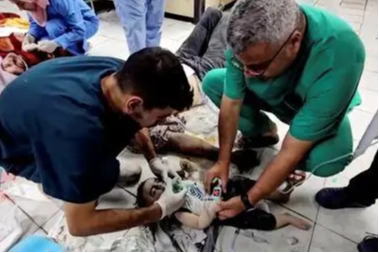
Gaza City, June 2 (RHC)-- The United Nations says only 14 out of 36 hospitals in the war-torn Gaza Strip are still partially functional, warning about growing environmental risks in the besieged Palestinian territory.
In a post on X, the UN Office for the Coordination of Humanitarian Affairs (OCHA) in the occupied Palestinian territory sounded the alarm about the collapsing health system, stressing that the 14 operating hospitals in Gaza cannot function fully.
“Only 14 of #Gaza’s 36 hospitals are functional, all of them partially. Risks are on the rise due to fuel shortages, limited clean water, sewage overflow, waste accumulation, and infrastructural damage,” the UN agency said.
The agency also warned that due to the ongoing war in the coastal sliver of land, a number of environmental hazards are worryingly on the rise. Last month, the Palestinian Health Ministry said in a report that Israeli forces had killed at least 500 medical personnel across Gaza since the Israeli genocide started last October.
A group of physicians who had just recently returned from humanitarian missions in the Gaza Strip once again called on the administration of US President Joe Biden to put an end to the occupying regime’s brutal war on the impoverished territory.
“The situation in Gaza, when I was there in March, was already catastrophic and I think we’re starting to see evidence that it’s getting a lot worse,” Dr. Tammy Abughnaim was quoted as saying by media.
Abughnaim, who is a board-certified emergency physician from Illinois, added that conditions in Gaza are getting “much, much worse” as the Tel Aviv regime further intensifies its attacks on the southern city of Rafah.
“I did not think it was possible … but right now I think we’re seeing (increasing) levels of (a) catastrophic, disastrous situation for the Palestinians that are there, all imposed by Israeli actions,” she added.
Speaking about the challenges she faced as a doctor in Gaza, Abughnaim said they were not able to “effectively” deliver care because Israel blocked the flow of aid. “It was very hard for me to be able to see people and not be able to help them in the way that I wanted, because Israel is not allowing them,” she said.
Dr. Zaher Sahloul, who has worked in several war zones around the globe, also said Gaza “is the worst” he has ever seen, and that the situation there is so “catastrophic I cannot describe in words.” “This is different … It’s a nightmare. When we were in Rafah, you see the war in front of your eyes,” added Sahloul, who is the President of MedGlobal and a Pulmonary and Critical Care associate professor at the University of Illinois Chicago. He said many of the victims of the Israeli aggression on Gaza are women and children.
Dr. Thaer Ahmad, a Palestinian-American and Global Health Director of the emergency department at Advocate Christ Medical Centre in Chicago, have the experience of working at the Nasser Medical Complex in the southern Gaza city of Khan Yunis. “To me, as somebody who’s been on the ground, I can only remember the faces of the children who have been bombed. I only think about everything that has happened to them,” he said, adding that he witnessed horrors in Gaza that he would not forget for the rest of his life.
Israel launched its current onslaught against the Gaza Strip, targeting hospitals, residences, and houses of worship after Palestinian resistance fighters launched a surprise attack, dubbed Operation al-Aqsa Storm, against the regime on October 7.
Nearly 36,300 Palestinians have been killed, most of them women and children. More than 1.7 million people have been internally displaced during the war as well.

